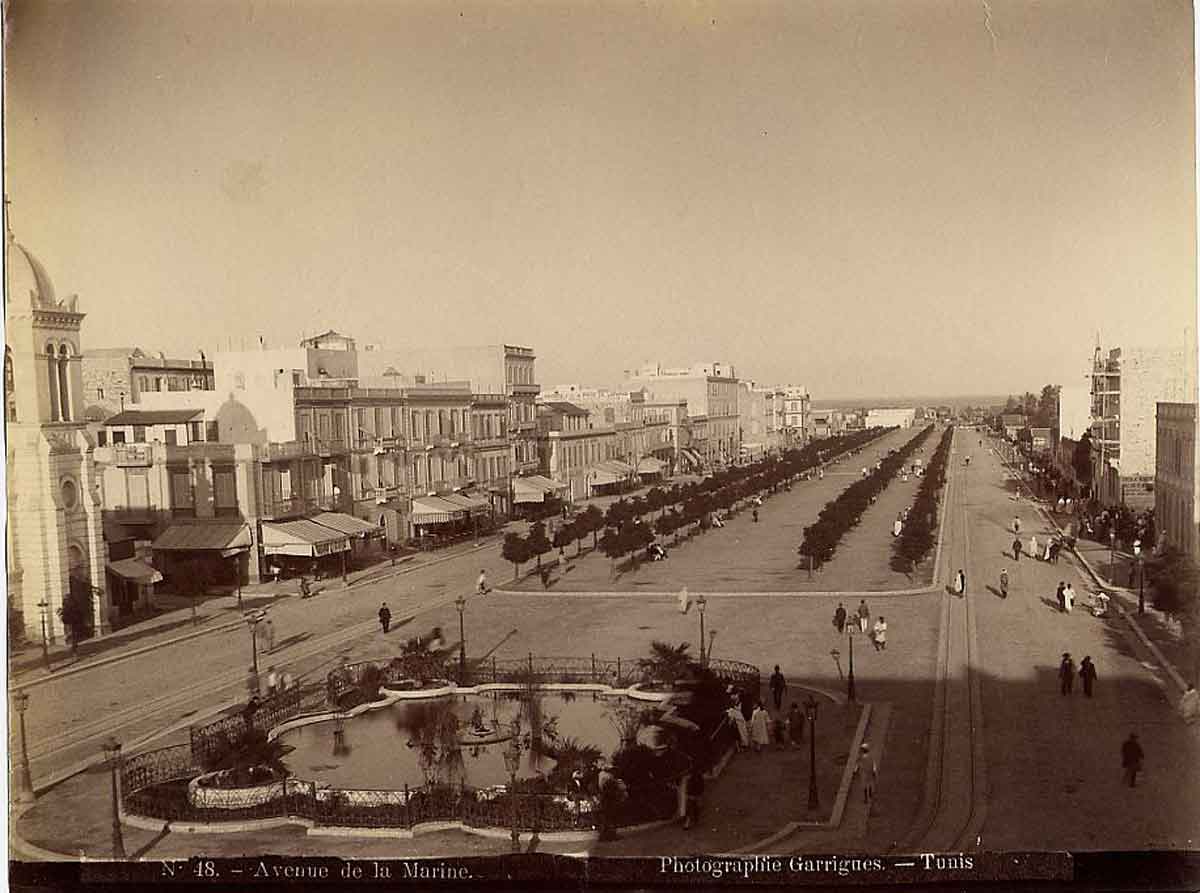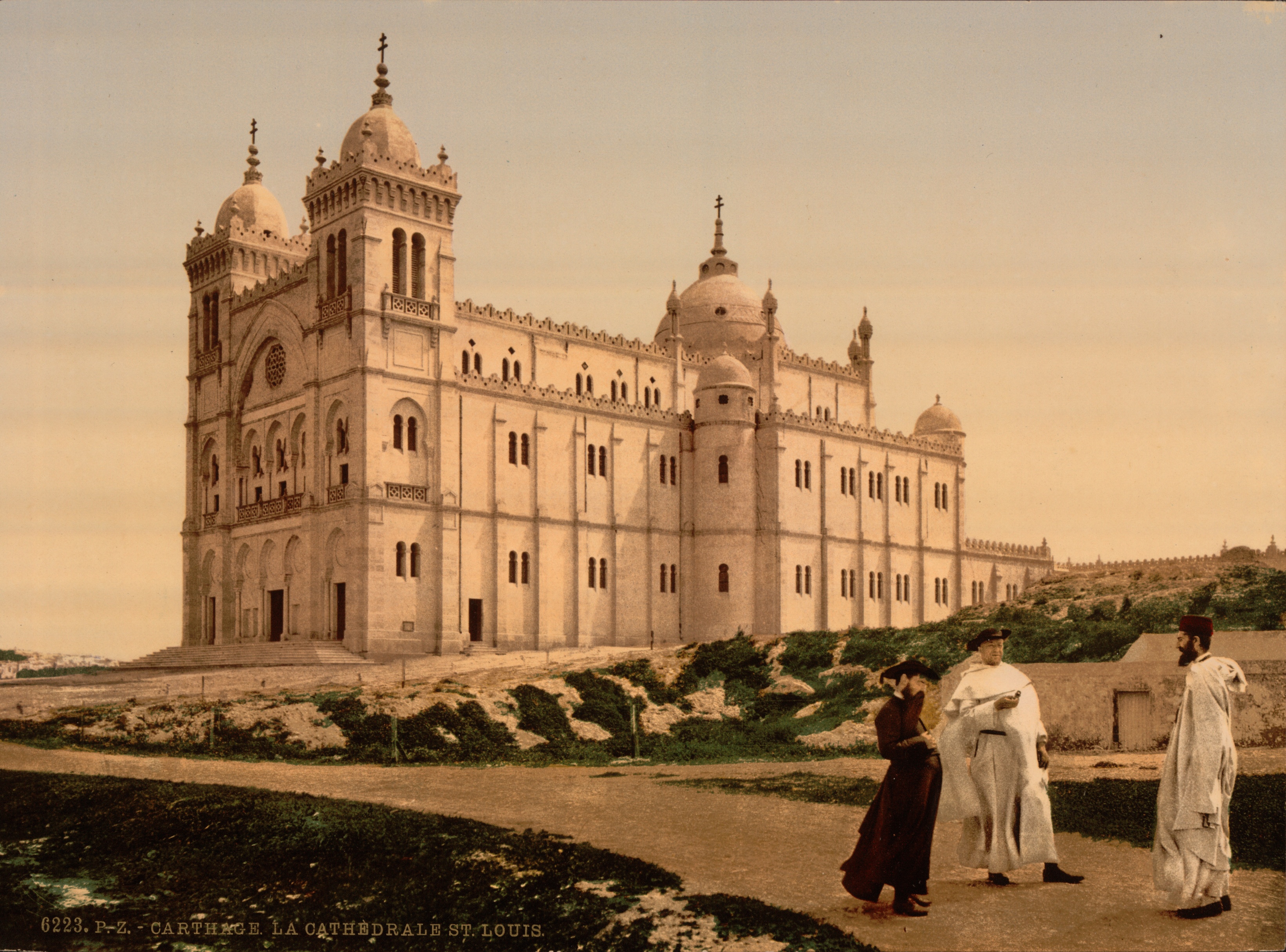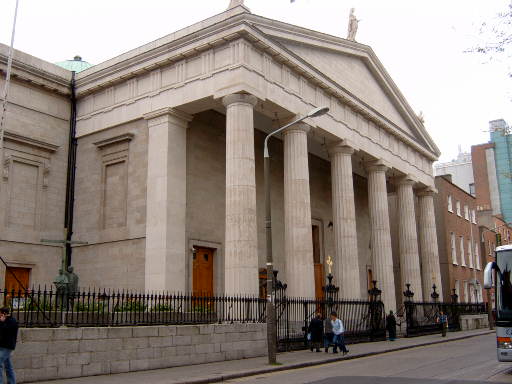|
Cathedral Of St Vincent De Paul
The Cathedral of St. Vincent de Paul (french: Cathédrale Saint-Vincent-de-Paul de Tunis) is a Roman Catholic church located in Tunis, Tunisia. The cathedral is dedicated to Saint Vincent de Paul, patron saint of charity. It is the episcopal see of the Archdiocese of Tunis and is situated at Place de l'Indépendence in Ville Nouvelle, a crossroads between Avenue Habib Bourguiba and Avenue de France, opposite the French embassy. The church, designed by L. Bonnet-Labranche, was built in a mixture of styles, including Moorish revival, Gothic revival, and Neo-Byzantine architectural traditions. The cornerstone was laid in 1890, and construction began in 1893. The church was opened on Christmas in 1897, albeit without its belltowers owing to a shortage of funds. The reinforced concrete towers were completed in 1910 using the Hennebique technique. Cardinal Charles Lavigerie laid the first stone for a church on 7 November 1881, a little further down Avenue de la Marine (now Avenue Ha ... [...More Info...] [...Related Items...] OR: [Wikipedia] [Google] [Baidu] |
Tunis
''Tounsi'' french: Tunisois , population_note = , population_urban = , population_metro = 2658816 , population_density_km2 = , timezone1 = CET , utc_offset1 = +01:00 , timezone1_DST = , utc_offset1_DST = , postal_code_type = Postal code , postal_code = 1xxx, 2xxx , area_code_type = Calling code , area_code = 71 , iso_code = TN-11, TN-12, TN-13 and TN-14 , blank_name_sec2 = geoTLD , blank_info_sec2 = .tn , website = , footnotes = Tunis ( ar, تونس ') is the capital and largest city of Tunisia. The greater metropolitan area of Tunis, often referred to as " Grand Tunis", has about 2,700,000 inhabitants. , it is the third-largest city in the Maghreb ... [...More Info...] [...Related Items...] OR: [Wikipedia] [Google] [Baidu] |
Avenue Habib Bourguiba
Avenue Habib Bourguiba ( aeb, شارع حبيب بورڨيبة) is the central thoroughfare of Tunis, and the historical political and economic heart of Tunisia. It is named for Habib Bourguiba, the first President of Tunisia and the national leader of the Tunisian independence movement. Today, the broad Avenue aligned in an east-west direction, lined with trees and facades of shops, and fronted with street cafes on both sides, and which is compared to the Champs-Élysées in Paris, and its extension, the Avenue de France, Place de l'Indépendance marking the central roundabout with Lake of Tunis at the eastern end. Many of the important monuments are located along this avenue, including Cathedral of St. Vincent de Paul, French Embassy in Tunisia and Théâtre municipal de Tunis. Most cities in Tunisia also have an Avenue Habib Bourguiba. History The road was originally known as the "Promenade de la Marine", a poor quality road which grew muddy in winter and dusty in summer. Wit ... [...More Info...] [...Related Items...] OR: [Wikipedia] [Google] [Baidu] |
Roman Catholicism In Tunisia
The Catholic Church in Tunisia is part of the worldwide Catholic Church, under the spiritual leadership of the Pope in Rome. Dioceses The Catholic church in Tunisia presently comprises only a single Latin archbishopric, in the national capital Tunis : * the non-Metropolitan Roman Catholic Archdiocese of Tunis. There are no Eastern Catholic, pre-diocesan or other exempt jurisdictions in Tunisia. As this solo-episcopate warrants no national conference, it partakes in the regional Episcopal conference of Northern Africa (French: ''Conférence Episcopale Régionale du Nord de l’Afrique'', C.E.R.N.A.) together with Algeria, Morocco (hosting the headquarters in Rabat), Western Sahara and Libya, the 'Great Maghreb' (Arab region West of Egypt). There is also an Apostolic Nunciature (papal diplomatic representation at embassy-level) to Tunisia, which is however vested in the Apostolic Nunciature to neighbour Algeria (in Algiers). All defunct jurisdictions are precursors of curre ... [...More Info...] [...Related Items...] OR: [Wikipedia] [Google] [Baidu] |
Acropolium Of Carthage
The Acropolium, also known as Saint Louis Cathedral (french: Cathédrale Saint-Louis de Carthage), is a former Roman Catholic church located in Carthage, Tunisia. The cathedral sits on the peak of Byrsa Hill, near the ruins of the ancient Punic and then Roman city. It was built atop the ruins of an old temple dedicated to Eshmun, the Punic god of healing. The edifice can still be accessed from the basement. Since 1993, the cathedral has been known as the "Acropolium". It is no longer used for worship, but instead hosts public events or concerts of Tunisian music and classical music. Currently, the only Roman Catholic cathedral operating in Tunisia is the Cathedral of St. Vincent de Paul in Tunis. History Hussein II Bey authorised the French consul-general to build a cathedral on the site of ancient Carthage, to determine where it would be situated, and to take all the land necessary for the project. His words were: The consul charged his son Jules with this duty, who conclude ... [...More Info...] [...Related Items...] OR: [Wikipedia] [Google] [Baidu] |
Holy See
The Holy See ( lat, Sancta Sedes, ; it, Santa Sede ), also called the See of Rome, Petrine See or Apostolic See, is the jurisdiction of the Pope in his role as the bishop of Rome. It includes the apostolic episcopal see of the Diocese of Rome, which has ecclesiastical jurisdiction over the Catholic Church and the sovereign city-state known as the Vatican City. According to Catholic tradition it was founded in the first century by Saints Peter and Paul and, by virtue of Petrine and papal primacy, is the focal point of full communion for Catholic Christians around the world. As a sovereign entity, the Holy See is headquartered in, operates from, and exercises "exclusive dominion" over the independent Vatican City State enclave in Rome, of which the pope is sovereign. The Holy See is administered by the Roman Curia (Latin for "Roman Court"), which is the central government of the Catholic Church. The Roman Curia includes various dicasteries, comparable to ministries and ex ... [...More Info...] [...Related Items...] OR: [Wikipedia] [Google] [Baidu] |
Modus Vivendi
''Modus vivendi'' (plural ''modi vivendi'') is a Latin phrase that means "mode of living" or " way of life". It often is used to mean an arrangement or agreement that allows conflicting parties to coexist in peace. In science, it is used to describe lifestyles. ''Modus'' means "mode", "way", "method", or "manner". ''Vivendi'' means "of living". The phrase is often used to describe informal and temporary arrangements in political affairs. For example, if two sides reach a ''modus vivendi'' regarding disputed territories, despite political, historical or cultural incompatibilities, an accommodation of their respective differences is established for the sake of contingency. In diplomacy, a ''modus vivendi'' is an instrument for establishing an international accord of a temporary or provisional nature, intended to be replaced by a more substantial and thorough agreement, such as a treaty. Armistices and instruments of surrender are intended to achieve a ''modus vivendi''. Examples ... [...More Info...] [...Related Items...] OR: [Wikipedia] [Google] [Baidu] |
Saint Louis Cathedral, Carthage
The Acropolium, also known as Saint Louis Cathedral (french: Cathédrale Saint-Louis de Carthage), is a former Roman Catholic church located in Carthage, Tunisia. The cathedral sits on the peak of Byrsa Hill, near the ruins of the ancient Punic and then Roman city. It was built atop the ruins of an old temple dedicated to Eshmun, the Punic god of healing. The edifice can still be accessed from the basement. Since 1993, the cathedral has been known as the "Acropolium". It is no longer used for worship, but instead hosts public events or concerts of Tunisian music and classical music. Currently, the only Roman Catholic cathedral operating in Tunisia is the Cathedral of St. Vincent de Paul in Tunis. History Hussein II Bey authorised the French consul-general to build a cathedral on the site of ancient Carthage, to determine where it would be situated, and to take all the land necessary for the project. His words were: The consul charged his son Jules with this duty, who conclu ... [...More Info...] [...Related Items...] OR: [Wikipedia] [Google] [Baidu] |
Carthage
Carthage was the capital city of Ancient Carthage, on the eastern side of the Lake of Tunis in what is now Tunisia. Carthage was one of the most important trading hubs of the Ancient Mediterranean and one of the most affluent cities of the classical world. The city developed from a Canaanite Phoenician colony into the capital of a Punic empire which dominated large parts of the Southwest Mediterranean during the first millennium BC. The legendary Queen Alyssa or Dido, originally from Tyre, is regarded as the founder of the city, though her historicity has been questioned. According to accounts by Timaeus of Tauromenium, she purchased from a local tribe the amount of land that could be covered by an oxhide. As Carthage prospered at home, the polity sent colonists abroad as well as magistrates to rule the colonies. The ancient city was destroyed in the nearly-three year siege of Carthage by the Roman Republic during the Third Punic War in 146 BC and then re-developed as Roman Car ... [...More Info...] [...Related Items...] OR: [Wikipedia] [Google] [Baidu] |
Roman Catholic Archdiocese Of Tunis
, local = ar, أبرشية تونسfrench: Archidiocèse de Tunis , image = , image_size = frameless , image_alt = , caption = , coat = , coat_size = , coat_alt = , coat_caption = , country = , territory = , province = , deaneries = , headquarters = , coordinates = , area_km2 = , area_sqmi = 62,632 , area_footnotes = , population = 10,955,000 , population_as_of = , catholics = (number unknown) , catholics_percent = 1 , parishes = , churches = , congregations = , schools = , members = , denomination = Catholic , sui_iuris_church = Latin Church , rite = Roman Rite , established = , cathedral = St Vincent de Paul , cocathedral = , patron = , patron_title = , pr ... [...More Info...] [...Related Items...] OR: [Wikipedia] [Google] [Baidu] |
Pro-cathedral
A pro-cathedral or procathedral is a parish church that temporarily serves as the cathedral or co-cathedral of a diocese, or a church that has the same function in a Catholic missionary jurisdiction (such as an apostolic prefecture or apostolic administration) that is not yet entitled to a proper cathedral. A pro-cathedral is distinct from a ''proto-cathedral'', the term in the Roman Catholic Church for a former cathedral, which typically results from moving an episcopal see to another (usually new) cathedral, in the same or another city. In a broader context, the term "proto-cathedral" may refer to a church used by a bishop before the designation of a settled cathedral (or pro-cathedral). Usage Europe In Ireland, the term is used to specifically refer to St Mary's Pro-Cathedral in Dublin, the seat of the Roman Catholic archbishop of Dublin since the Anglican Reformation in Ireland, when Christ Church Cathedral and St Patrick's Cathedral became the property of the (Anglic ... [...More Info...] [...Related Items...] OR: [Wikipedia] [Google] [Baidu] |
Charles Lavigerie
Charles Martial Allemand Lavigerie (31 October 1825 – 26 November 1892) was a French cardinal (Catholicism), cardinal, Roman Catholic Archdiocese of Tunis, archbishop of Carthage and Roman Catholic Archdiocese of Algiers, Algiers and primate of Africa. He also founded the White Fathers. A Catholic Church, Catholic priest who became a bishop in France, Lavigerie established Catholic Church in France, French Catholic missions and missionary orders to work across Africa. Lavigerie promoted Catholicism among the peoples of North Africa, as well as the Black natives Sub-Saharan Africa, further south. He was equally ardent to transform them into French subjects. He crusaded against the slave trade, and he founded the order of priests called the White Fathers, so named for their white cassocks and red fezzes. He also established similar orders of brothers and nuns. He sent his missionaries to the Sahara, Sudan, Tunisia, and Tripolitania. His efforts were supported by the Pope and the G ... [...More Info...] [...Related Items...] OR: [Wikipedia] [Google] [Baidu] |
Belltower
A bell tower is a tower that contains one or more bells, or that is designed to hold bells even if it has none. Such a tower commonly serves as part of a Christian church, and will contain church bells, but there are also many secular bell towers, often part of a municipal building, an educational establishment, or a tower built specifically to house a carillon. Church bell towers often incorporate clocks, and secular towers usually do, as a public service. The term campanile (, also , ), deriving from the Italian ''campanile'', which in turn derives from ''campana'', meaning "bell", is synonymous with ''bell tower''; though in English usage campanile tends to be used to refer to a free standing bell tower. A bell tower may also in some traditions be called a belfry, though this term may also refer specifically to the substructure that houses the bells and the ringers rather than the complete tower. The tallest free-standing bell tower in the world, high, is the Mortegliano Be ... [...More Info...] [...Related Items...] OR: [Wikipedia] [Google] [Baidu] |






